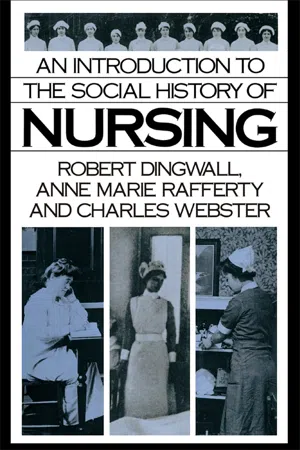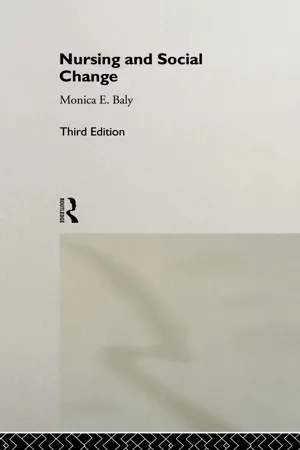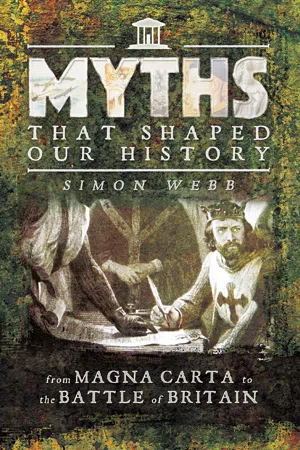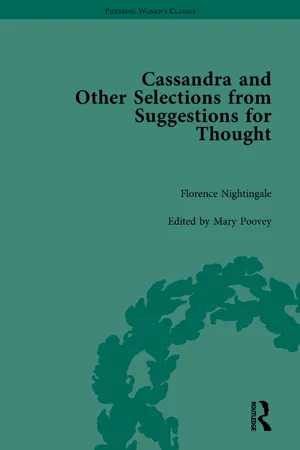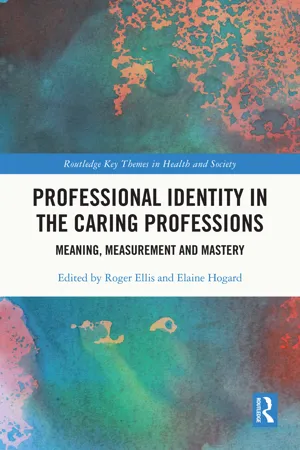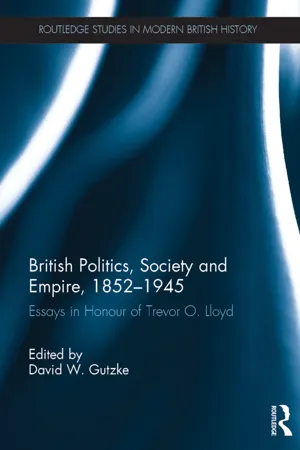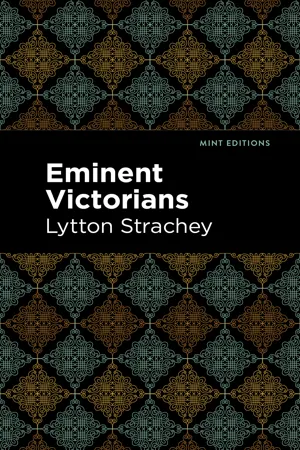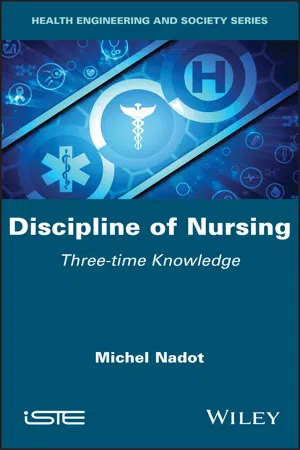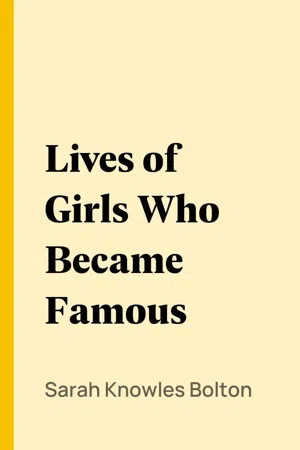History
Florence Nightingale
Florence Nightingale was a pioneering figure in the field of nursing during the 19th century. She gained prominence for her work in improving healthcare and hospital conditions, particularly during the Crimean War. Nightingale's emphasis on hygiene, sanitation, and patient care revolutionized nursing practices and laid the foundation for modern nursing education and standards.
Written by Perlego with AI-assistance
Related key terms
Related key terms
1 of 4
Related key terms
1 of 3
10 Key excerpts on "Florence Nightingale"
- eBook - ePub
- Britannica Educational Publishing, Kara Rogers(Authors)
- 2010(Publication Date)
- Britannica Educational Publishing(Publisher)
The nursing profession also has been strengthened by its increasing emphasis on national and international work in developing countries and by its advocacy of healthy and safe environments. The international scope of nursing is supported by the World Health Organization (WHO), which recognizes nursing as the backbone of most health care systems around the world.Florence Nightingale
(b. May 12, 1820, Florence [Italy]—d. Aug. 13, 1910, London, Eng.)Florence Nightingale was a statistician and social reformer and the foundational philosopher of modern nursing. Nightingale was put in charge of nursing British and allied soldiers in Turkey during the Crimean War. She spent many hours in the wards, and her night rounds giving personal care to the wounded established her image as the “Lady with the Lamp.” Her efforts to formalize nursing education led her to establish the first scientifically based nursing school—the Nightingale School of Nursing, at St. Thomas’ Hospital in London (opened 1860). She also was instrumental in setting up training for midwives and nurses in workhouse infirmaries. She was the first woman awarded the Order of Merit (1907).FAMILY TIES AND SPIRITUAL AWAKENINGFlorence Nightingale was the second of two daughters born, during an extended European honeymoon, to William Edward and Frances Nightingale. (William Edward’s original surname was Shore; he changed his name to Nightingale after inheriting his great-uncle’s estate in 1815.) Florence was named after the city of her birth. After returning to England in 1821, the Nightingales had a comfortable lifestyle, dividing their time between two homes, Lea Hurst in Derbyshire, located in central England, and Embley Park in warmer Hampshire, located in southcentral England. Embley Park, a large and comfortable estate, became the primary family residence, with the Nightingales taking trips to Lea Hurst in the summer and to London during the social season.Florence was a precocious child intellectually. Her father took particular interest in her education, guiding her through history, philosophy, and literature. She excelled in mathematics and languages and was able to read and write French, German, Italian, Greek, and Latin at an early age. Never satisfied with the traditional female skills of home management, she preferred to read the great philosophers and to engage in serious political and social discourse with her father. - eBook - ePub
- Robert Dingwall, Anne Marie Rafferty, Charles Webster(Authors)
- 2002(Publication Date)
- Routledge(Publisher)
Chapter three The New Model Nurse
One of the great problems for anybody studying the history of nursing in the nineteenth century is to find a way of coming to terms with the powerful and enigmatic figure of Florence Nightingale, a woman who became the stuff of which myths are made even in her own lifetime. In this chapter, however, we shall try to place her in a social context as a woman of her class and time. As we have seen, the care of the sick was already changing in many ways which were ultimately to produce the modern occupation of nursing. Florence Nightingale’s work was part of that process and undeniably made a major contribution to its outcome. But that result was a compromise between Miss Nightingale’s vision and the realities of mid-Victorian life, values and institutions; a compromise shaped by the hands of many other women and men. The ‘New Nurse’ turned out to retain a surprisingly large number of features of the old.Florence Nightingale: woman and myth
The difficulty of assessing the contribution of Florence Nightingale to nursing reform in the nineteenth century is that so much of the writing about her has been biographical rather than historical. This has, perhaps, been encouraged by the mass of her own papers which present vivid, if often selective, melodramatic and egotistic accounts and judgements of other people and events. Florence Nightingale’s life has taken on the function of a ‘heroine legend’ in nursing, a morality tale to inspire her successors (Whittaker and Oleson 1964). To see her, rather, as part of a social movement is not to detract from her contribution but is to acknowledge the complex relationship between individuals and their circumstances in the making of history.Thus, some of the more breathless accounts of her early life try to trace Florence Nightingale’s mission to nursing in events of her childhood and youth, an attempt in which they are encouraged by her own reconstructions in late middle age. Cook (1913:14), her first scholarly biographer, puts these in perspective: - eBook - ePub
- Monica F. Baly(Author)
- 2002(Publication Date)
- Routledge(Publisher)
Chapter 9 The influence of Florence NightingaleFlorence Nightingale was literally a legend in her own day. Neither the miasma of sentimentality, nor the exegesis of psychologists nor modern scholarship can destroy her achievements. For the best part of 50 years she laboured unremittingly for the ‘sake of the work’. She is rightly remembered for her work in the Crimean War, but work for nursing is but a small part of her reforming zeal. The Army Medical Service possibly owes more to her than does nursing. She probably made a greater impact on Poor Law nursing than on general nursing, and her designs for hospitals and barracks have stood the test of time for a longer period than probably her presentday successors can expect for theirs. It is not for nothing that Cecil Woodham-Smith, her biographer, described her as The Greatest Victorian of them all’.1EARLY LIFEFlorence Nightingale was born in Italy in 1820 while her family was on the ‘Grand Tour’. Her parents were wealthy, and her mother, Fanny, was a great beauty and a successful hostess, W.E.N., her father, was a cultivated man with liberal views. As his estate was entailed the fact that there was no son was a disaster, but he took great pains with the education of his two daughters, Parthe and Florence, which he largely supervised himself. Neither girl inherited Fanny’s striking beauty, but Florence was graceful, quick and an apt pupil. However, she was not a comfortable child and did not fit into the restless round of the Nightingale homes. This was partly because she resented the unhealthy life of idleness, which resulted in depressive brooding. She tried to fill the emptiness by excessive devotion to favourite members of the large Nightingale family, to good works in the neighbourhood, and at one time she felt that she had a vocation for mathematics. There is no doubt but that her brooding and imagination led her to over-dramatise the situation, a tendency that remained with her for life, but which sometimes produced that telling aphorism. Then at the age of 17 years she received a ‘call from God’. Unhappy and taut she was in fact living in a dream world, but she was always adamant that the voice was clear, and although she did not then know what the voice called her to do it affected her subsequent decisions. In spite of this she went to Italy where she was a social success and where she became imbued with the idea of Italian freedom and liberation, in the cause of which she declared herself prepared ‘to go to the barricades’.2 - eBook - ePub
Myths That Shaped Our History
From Magna Carta to the Battle of Britain
- Simon Webb(Author)
- 2017(Publication Date)
- Pen & Sword History(Publisher)
Chapter 6
Florence Nightingale in Scutari 1854–1855: ‘A Lady with a Lamp shall stand, In the great history of the Land’
F lorence Nightingale is the very epitome of one of the British mythic archetypes at which we have been looking. She is the personification of the little person who takes on authority, standing up to the leadership of the British Army at the height of the Empire and bending them to her will. At a time when a woman’s place was most definitely in the home, here was one woman who not only refused to stay at home, but actually went to war in order to protect the welfare of wounded and ill men. The ‘Lady of the Lamp’ is the closest thing which the British have to a national heroine. She has even been awarded the accolade of appearing on the currency; from 1975 to 1994, Florence Nightingale was to be found on £10 notes, leading to that denomination becoming colloquially known as a ‘Nightingale’.There can surely be very little to say on the subject of Florence Nightingale’s work; this, after all, is the woman responsible for the establishment of nursing in its modern form. She raised nursing from being the occupation of drunken slatterns such as Sarah Gamp, in Dickens’ Martin Chuzzlewit, to the honourable profession which it is today.The difficulty with criticizing and deconstructing the myth of Florence Nightingale and her activities in Turkey is that it makes many people feel uncomfortable. It seems almost churlish and small-minded, a century and a half after her work, to pick apart and quibble over the details of what she actually achieved. After all, it must surely be indisputable that she at least did more good than bad and that the lot of those casualties of the Crimean War would have been far less pleasant and considerably more hazardous, had Florence Nightingale not taken charge of the hospital at Scutari? This is certainly the view of most people today. Here is what a popular children’s history book, published by the Oxford University Press, has to say on the matter: - Florence Nightingale(Author)
- 2017(Publication Date)
- Routledge(Publisher)
INTRODUCTIONMost modern readers associate Florence Nightingale with one of two nineteeth-century campaigns – the creation of modern nursing or the feminist protest against the enforced idleness of middle-class women. Nightingale’s reform of nursing (and, perhaps even more significantly, of military hospitals) and her personal demonstration that women could work were undoubtedly her most visible accomplishments, but Nightingale’s own reflections on this work reveal that all of her activities were expressions of a complex and unorthodox religious philosophy, which was largely developed before Nightingale left for the East in 1854. Suggestions for Thought to the Searchers after Truth Among the Artizans of England, which is published here for the first time, contains Nightingale’s most sustained treatment of religious ideas.1 A major contribution to the religious controversies of the 1850s, Suggestions for Thought also explains the reconceptualization of power that underwrote Nightingale’s own emotional and intellectual transformation from a frustrated upper-class daughter to the indomitable heroine of a foreign war. As a meditation on the relationship between individual frustrations and the working out of a divine plan, it constitutes Nightingale’s contribution to understanding – and resisting – the place that women were alloted in mid nineteenth-century Britain.The heart of the three-volume, 829-page Suggestions for Thought was probably composed between 1850 and 1852. Night-ingale’s first mention of what she variously called the ‘Works’ and the ‘Stuff’ appears in a letter to her father composed on her thirty-second birthday (12 May, 1852). Sir Edward Cook, Nightingale’s first modern biographer, describes the ‘works’ as consisting of two manuscript books – one entitled ‘Religion’, the other ‘Novel’.2 Cook argues that the novel format was abandoned after 1852, although traces of this genre remain in the section of Volume II entitled ‘Cassandra’. Scholars agree that the manuscript hook entitled ‘Religion’ was elaborated and enlarged sometime between Nightingale’s return from the Crimea in 1856 and its printing in 1860. Nightingale sought responses to her religious doctrine as early as 1852, when she asked the liberal MP and family friend Richard Monckton Milnes to ‘look over certain things which I have written for the working-men on the subject of belief’ (Cook I, 121). Not until it was privately printed in 1860, however, did the expanded Suggestions receive more than a few readings. In that year Nightingale sent copies to six readers including, most notably, the philosopher John Stuart Mill and the Regius Professor of Greek at Oxford, Benjamin Jowett.3 While neither recommended publishing Suggestions- eBook - ePub
Professional Identity in the Caring Professions
Meaning, Measurement and Mastery
- Roger Ellis, Elaine Hogard, Roger Ellis, Elaine Hogard(Authors)
- 2020(Publication Date)
- Routledge(Publisher)
The professional identity of nursing is comparatively young when compared with other professional groups (eg medicine) and this is significant. It is important to note that during the last 100 years of development in particular, nursing has thus faced challenges to the very nature of professional identity and how any claim to such a definition might be justified. This chapter will consider collective definitions of nursing as a professional organisation and examine historical contexts in relation to the changing perceptions and public images of nurses over time. Changing world contexts relating to the way in which professional identity may be viewed is also important and impacts upon professional status. The chapter also considers contemporary global nursing and the complexity of professional identity across different sociological contexts. The role of personal identity of the individual in determining professional identity is also critical and will be considered to illuminate ways that professional identity is described, conceptualised and operationalised in relation to nursing. Evidence about how professional identity has been measured and applied will be using best empirical evidence from key studies, notably those by Aiken et al (2014) in relation to the impact of registered nurses on patient outcomes and also the Tuning Educational Structures in Europe (Tuning Study) (2011) and its contribution in defining educational characteristics of the profession of nursing. Finally, the chapter will look forward in exploring ways in which professional identity can be taught to nursing students today and learnt by those becoming professionals. The importance of nurses as leaders is a fundamental component in concluding this discussion and will explore the contemporary trend of ensuring preparing young leadership identities for nursing through education and exemplary practice as one means for providing for a strong future profession.The World Health Organisation (2020) identified 2020 as the International Year of the Nurse with the intention of further raising the profile of nursing across the world. It is thus a timely and relevant opportunity for this chapter to reflect on the professional identity of the nurse today.Setting the scene – early identities
Modern nursing popularly identifies Florence Nightingale as a key historical instigator in defining nursing. Nightingale's books and writings (especially ‘Notes on Nursing – What it is and What it is not’ (1865) held a global appeal. Her observations moved a considerable way towards establishing the singularity of the nurses’ role that could be considered more than an unprepared assistant to the fast emerging hospital-based medical profession of the time, particularly in Western Europe and the United States. Nightingale identified how nurses could use their voices to create change and enable better patient care in a way that went beyond the pure remit of medical treatment of patients. She embraced the need for nurses to promote well-being and a safe environment for the maintenance of homoeostasis and the provision of holistic patient care, and recognised the need for some nurses (although not all) to engage with and to understand best evidence in order for effective care to be assured. Nightingale's view on professionalism was strongly focussed upon the vocational nature of the work of nursing and the responsibilities of the individual nurse for their own quality of nursing provided. Today, personal identity is recognised as one component of an extremely complex concept of professionalism in nursing, yet it is important. - eBook - ePub
British Politics, Society and Empire, 1852-1945
Essays in Honour of Trevor O. Lloyd
- David W. Gutzke(Author)
- 2017(Publication Date)
- Routledge(Publisher)
In conclusion, was Nightingale really the founder of modern nursing? One could make a good argument that Nightingale’s contributions to modern nursing were largely destructive. Her efforts to spread the new nursing throughout the Empire were unsuccessful. Osburn made major improvements in Sydney, but Nightingale repudiated them. Machin established a far superior nursing service in Montreal, but felt forced to resign before she was fired. Nightingale’s attempts to produce religiously dedicated nurses failed, but they nevertheless haunted nursing long after her death, providing a justification for the long hours, harsh working conditions and low wages of nurses in the twentieth century. Her refusal to come to terms with either the new woman or a more secular society, and her insistence on close personal surveillance of probationers when it was no longer necessary, intensified the long-standing central problem of nursing’s inability to recruit and retain the kind of educated women it most needed. Nightingale was unable to establish systematic instruction; her support of Wardroper, and lack of support for the nurses and probationers who had to work under Wardroper, made the school one of the most backward in London. Other new nineteenth-century professions, such as architecture, accountancy or engineering, defined themselves in terms of their specialized professional knowledge. Nightingale’s gendered definition of nursing differed radically in the way it valued motherliness together with religious commitment above professional knowledge, an approach which has had a lasting influence on the way the public understands nursing. Even today it is difficult to convince many people that nursing is a knowledge-based practice.The thesis that Nightingale’s contributions to nursing were destructive has merit but is not completely fair. Nightingale cannot be considered the sole founder of modern nursing, but she did make positive contributions and must be considered one of its founders. Her magnificent work in the Crimean War not only gave nursing a heroine but made the public aware of the difference good nursing can make. Furthermore, in the deferential society of Victorian England, Nightingale’s elite social position went a long way in making nonsisterhood nursing respectable. Nevertheless, the Anglican Sisters, Wardroper and the St. Thomas’s governors’ complete control of the Nightingale School had more influence on the development of the so-called Nightingale system than did Nightingale. The sisterhoods’ introduction of respectability, better living and working conditions, and systematic clinical instruction was fundamental to the start of nursing reform. Unfortunately, their system foundered for many of the same reasons that Osburn and Machin failed: conservative hospital governors were not prepared to give women so much authority in the public sphere. Yet it was from St. John’s House that Nightingale derived her (unachieved) aim of systematic instruction on the wards. Unlike the sisterhoods, Wardroper and the St. Thomas’s governors shaped modern nursing in a damaging way. Wardroper created the complete disjunction between clinical work and instruction, a system which severely diminished the educational aspect of nursing school. Wardroper’s legacy has lasted into our own time when, in striking contrast to professors of medicine, few professors of nursing work clinically, leaving many, like Crossland, out of touch with current practice. The contract which the St. Thomas’s governors negotiated with the Nightingale Fund was another key factor in determining the future of nursing. It enabled hospital administrators to use probationers as a cheap, jack-of-all-trades, 24-hour, in-house service. This would continue until well after World War II. The cachet of the Nightingale name and the fact that the Nightingale training system was one of the cheapest in London were the two key factors making the Nightingale School pre-eminent and the model of the future.137 - Fergus Hume(Author)
- 2021(Publication Date)
- Mint Editions(Publisher)
LORENCE NIGHTINGALEI
EVERY ONE KNOWS THE POPULAR conception of Florence Nightingale. The saintly, self-sacrificing woman, the delicate maiden of high degree who threw aside the pleasures of a life of ease to succour the afflicted; the Lady with the Lamp, gliding through the horrors of the hospital at Scutari, and consecrating with the radiance of her goodness the dying soldier’s couch. The vision is familiar to all—but the truth was different. The Miss Nightingale of fact was not as facile as fancy painted her. She worked in another fashion and towards another end; she moved under the stress of an impetus which finds no place in the popular imagination. A Demon possessed her. Now demons, whatever else they may be, are full of interest. And so it happens that in the real Miss Nightingale there was more that was interesting than in the legendary one; there was also less that was agreeable.
Her family was extremely well-to-do, and connected by marriage with a spreading circle of other well-to-do families. There was a large country house in Derbyshire; there was another in the New Forest; there were Mayfair rooms for the London season and all its finest parties; there were tours on the Continent with even more than the usual number of Italian operas and of glimpses at the celebrities of Paris. Brought up among such advantages, it was only natural to suppose that Florence would show a proper appreciation of them by doing her duty in that state of life unto which it had pleased God to call her—in other words, by marrying, after a fitting number of dances and dinner-parties, an eligible gentleman, and living happily ever afterwards. Her sister, her cousins, all the young ladies of her acquaintance, were either getting ready to do this or had already done it.It was inconceivable that Florence should dream of anything else; yet dream she did. Ah! To do her duty in that state of life unto which it had pleased God to call her! Assuredly, she would not be behindhand in doing her duty; but unto what state of life HAD it pleased God to call her? That was the question. God’s calls are many, and they are strange. Unto what state of life had it pleased Him to call Charlotte Corday, or Elizabeth of Hungary? What was that secret voice in her ear, if it was not a call? Why had she felt, from her earliest years, those mysterious promptings towards… she hardly knew what, but certainly towards something very different from anything around her? Why, as a child in the nursery, when her sister had shown a healthy pleasure in tearing her dolls to pieces, had SHE- eBook - ePub
Discipline of Nursing
Three-time Knowledge
- Michel Nadot(Author)
- 2020(Publication Date)
- Wiley-ISTE(Publisher)
There is a wide range of approaches to the criticism of knowledge or the analysis of the epistemological status of our different types of knowledge. Certainly, “research activities make it possible to refine existing theories and to contribute, on the basis of new knowledge, to the development of other theories that will guide action or change in nursing practices” [DUC 02]. But what links can be made, for example, between our pre-Nightingale language traditions and nursing diagnoses, the evidence-based movement (EBM) or advanced nursing practices (ANP)? These links appear in Figure 10.2, but they are not constant. Rousseau concluded: “Nurses would benefit from being aware of the historical roots of their profession and using them to better define the type of services they can provide to society” [ROU 97]. This is precisely the singular theme of our work! The historical roots of the profession show that the service rendered to society by nurses is much broader than what is said. 10.2. Historical constants of the discipline As in many fields of knowledge, contemporary knowledge builds on previous knowledge. There are historical constants that span the centuries. Recognizing them allows us to apply or develop them and avoids inventing new roles. Long before Florence Nightingale, what we knew how to do was already transmitted to us by elders. The nursing knowledge of a period often integrates that of previous periods in order to keep it alive [PÉP 08]. What do we do with this ancient knowledge that is still alive today? The aristocratic knowledge of the “mistress or housekeeper” mobilized by Florence Nightingale is certainly useful for organizing the space and time of care and promoting hygiene, but it is neither the first nor the only one to structure the discipline - eBook - ePub
- Sarah Knowles Bolton(Author)
- 2004(Publication Date)
- Perlego(Publisher)
Finally the war came to an end. London was preparing to give Miss Nightingale a royal welcome, when, lo! she took passage by design on a French steamer, and reached Lea Hurst, Aug. 15, 1856, unbeknown to any one. There was a murmur of disappointment at first, but the people could only honor all the more the woman who wished no blare of trumpets for her humane acts.Queen Victoria sent for her to visit her at Balmoral, and presented her with a valuable jewel; a ruby-red enamel cross on a white field, encircled by a black band with the words, "Blessed are the merciful." The letters V. R., surmounted by a crown in diamonds, are impressed upon the centre of the cross. Green enamel branches of palm, tipped with gold, form the framework of the shield, while around their stems is a riband of the blue enamel with the single word "Crimea." On the top are three brilliant stars of diamonds. On the back is an inscription written by the Queen. The Sultan sent her a magnificent bracelet, and the government, $250,000, to found the school for nurses at St. Thomas' Hospital.Since the war, Miss Nightingale has never been in strong health, but she has written several valuable books. Her Hospital Notes, published in 1859, have furnished plans for scores of new hospitals. Her Notes on Nursing, published in 1860, of which over one hundred thousand have been sold, deserve to be in every home. She is the most earnest advocate of sunlight and fresh air.She says: "An extraordinary fallacy is the dread of night air. What air can we breathe at night but night air? The choice is between pure night air from without, and foul night air from within. Most people prefer the latter,--an unaccountable choice. What will they say if it be proved true that fully one-half of all the disease we suffer from, is occasioned by people sleeping with their windows shut?
Index pages curate the most relevant extracts from our library of academic textbooks. They’ve been created using an in-house natural language model (NLM), each adding context and meaning to key research topics.
Explore more topic indexes
Explore more topic indexes
1 of 6
Explore more topic indexes
1 of 4

